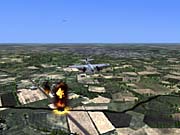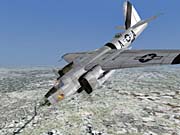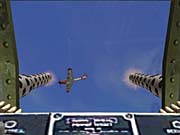You may fondly remember games from 10 or even 20 years ago, but the fact is, by today's higher standards, most of those classic games aren't much fun. That's not to say that they had no real impact at the time, because the best classic games aspired to new heights with what now seems like limited technology, and the gameplay of classic series evolved based on the idea that new games should offer more than last year's game with better graphics. Games back then weren't always groundbreaking, and they were sometimes redundant, but in the case of flight simulators, they were developed in order to come as close as possible to the real thing. Developers expended lots of effort on making planes look like more than just a pile of moving squares and triangles, and the physics engines they created pushed the limits of computers without really approaching the realistic behavior of a plane in flight. Ten years ago, the idea of a flight simulator with photo-realistic graphics was a fantasy, but now it seems possible for developers to create an all-encompassing flight simulator that's both realistic and fantastic looking. Is Microsoft's Combat Flight Simulator 3: Battle for Europe this game?

While the first Combat Flight Simulator was a spin-off of the Flight Simulator franchise and made many compromises, the first game did a good job of putting a good graphics engine together with accurate flight physics in a consistent manner. More importantly, it gave players a chance to revisit the Pacific theater of World War II, which had been conspicuously missing from flight simulators for years. So at the time, it was easy to forgive some omissions, like the fact that even though the game simulated the conflict in the Pacific theater, there were no flyable dive- or torpedo-bombers. On the surface, Combat Flight Simulator 3 seems to have addressed the biggest outstanding issues of its predecessor: the lack of both a dynamic campaign and a decent multiplayer component. Combat Flight Simulator 3 has an interesting campaign in which you can affect the progress of the ground war (both directly, through successful missions, and indirectly, through launching ground offensives by spending points earned in combat). In addition, the game has cooperative multiplayer (albeit only for single missions) in which you can fly both bombers and fighters. On paper, the game has almost everything you'd want. But once you actually get in the air, it's a somewhat different experience.
The game ships with 18 different aircraft, all of which are flyable. For the British, this includes the Spitfire, the Typhoon, the Tempest, the Mosquito, the (US-designed) B-25 Mitchell, and the Vampire jet. The Americans get the P-47 Thunderbolt, the P-51 Mustang, the B-26 Marauder, the P-38 Lightning, the P-80 Shooting Star jet, and the experimental Curtiss P-55 Ascender. German pilots can fly the Me-109, the FW-190, the Ju-88, the Me-262 jet fighter, and the distinctly odd Go-229 and Do-335. Many of the aircraft have variants, which brings the absolute total to more than 30. However, if you don't see any of your other favorite planes in the above list, they're not in the game. That means that in this simulation of air combat over Europe from 1943 to 1945, you'll never see a Flying Fortress or a Liberator. It's as odd as not being able to fly Dauntlesses in Combat Flight Simulator 2.
Apparently, these omissions were a side effect of the developers' focus on their brand-new terrain engine, which is supposed to make down-low flying as visually attractive as flying at high altitudes. For the most part it succeeds, although on the whole it's rather uneven. The trees and buildings look nice, but some of the ground textures are a bit off, and sometimes the effect can be spoiled. In any case, focusing on the appearance of the ground is certainly an unusual way to approach a flight simulation.
But these detailed terrain graphics have a price: steep hardware requirements. Even with a high-end processor, you won't be able to get the most out of the game visually unless you also have a high-end graphics card, which isn't normally the case with flight sims. On a 2.4GHz Pentium 4 machine, we were unable to run the game well without turning the graphics down--even at 1280x1024--until we replaced the GeForce 3 with a GeForce 4. We also experienced some stuttering at all resolutions.

The aircraft models are, in general, gorgeous, and the virtual cockpits are as good as they were in Combat Flight Simulator 2, complete with moving control surfaces. The flight models are quite good, and they show the differences between the aircraft very well. On the higher realism settings, the game does a very nice job of modeling all sorts of factors, like engine torque, which can make takeoffs challenging for new pilots. The game's damage modeling is also good, since Combat Flight Simulator 3 has good special effects to display damage in the air and on the flight models. Both the graphics and the realistic physics are scalable, which should make the game accessible to players with a wide variety of skill levels and computer hardware. In short, everything about the actual planes themselves, from their appearance (inside and out) to their behavior, is excellent. The planes are clearly the best part of the sim, though the game's impressive volumetric clouds also look excellent, and actually provide a tactical advantage, since you can often hide within the clouds themselves.
The multiplayer options have been enhanced since the previous Combat Flight Simulator, and it's now possible to play single missions cooperatively, although not the campaign. There are a number of one-shot historical missions included, and there are plenty of different mission options as well. Competitive multiplayer is also supported, of course.

It's easy to understand the choice of flyable aircraft for this game, especially given the campaign structure. As you progress through the campaign, you get access to new aircraft, and by the end of the campaign, you'll be flying around in brand-new jets. You can also customize your aircraft with different paint schemes. There is even a role-playing element that involves using points you earn by flying to boost skills like vision, G-force tolerance, and health. Progressing through the war, and thus through better aircraft, gives the campaign its continuity. The jets toward the end are something of a reward.
The dynamic campaign is a big part of the game, and it offers a lot of choices in terms of missions. The game generates a list of possible missions for different sectors of the map, and if you successfully complete them, you eventually advance the front line in that area. If you earn enough prestige points, you can initiate a ground offensive in a certain sector, which has the effect of moving the front on a larger scale. But this costs a lot of prestige, so pulling off a ground offensive requires some element of strategy. It's a great idea, and it's further fleshed out by the fact that the game generates airfields, flak, and other things wherever you fly. If you stray from your objective, you may find yourself in deep trouble. The campaign front line doesn't always follow the success of your missions, however, which can be frustrating because you'll find yourself winning battles but losing the war. If the core gameplay were better, it would matter less.
There are a number of quirks in the game engine, as well. One of the strangest is the way in which the AI pilots turn level bombers into dive-bombers. It's odd to see B-25 Mitchells suddenly dive to take out a bridge. Bombers also have a problem in that not all tracers at their gun positions align with the guns' sights. This makes gunnery much more challenging at times, and definitely more frustrating. While the general aircraft sounds are well done, the airwaves are strangely silent, except when your wingmen acknowledge your orders. Otherwise, it's as if you're fighting a one-man war. Lastly, there isn't a flight recorder in the game, even though it is mentioned in the documentation. Apparently, it was cut from the game at a very late stage. The game also doesn't have any mission builder.
Once you've had a chance to sit down and play the game, you may get the impression that the developers were still trying to solve the problems of 1996, while the rest of the world has moved on to other issues. As mentioned earlier, the game's flight models are good, and the graphics are great. End of story, right? Six years ago, sure. But more recently, European Air War from 1998 was neither the best-looking sim of its time, nor the one with the most accurate flight model, but in that year's crowded flight simulator market, it was the only World War II simulation that made a lasting impression. This wasn't an accident.

There have been a few landmark sims in recent years that really pushed the limits of what we expect from these types of games, albeit in very different ways--games that not only modeled cockpits, takeoffs, landings, and dogfights, but also actually integrated all these elements into missions and campaigns that really made you feel as though you were part of the action. Combat Flight Simulator 3, on the other hand, makes you feel like you're using a really nice-looking, technically accurate computer program. It certainly has its appeal, but after what has been done over the past few years in games like Rowan's Battle of Britain and IL-2 Sturmovik, it's disappointing to see such technical excellence in the service of such a narrow vision.
If you're new to flight sims and want to fly Mustangs, Thunderbolts, Focke-Wulfs, and other planes in a variety of interesting missions in the best World War II western front flight sim available, find a copy of European Air War. It's cheap, and it will run smoothly on today's systems. On the other hand, if you're a longtime flight sim fan who has played that title to death already and you're eager for another visit to the western front, Combat Flight Simulator 3 is a reasonable choice. Just make sure you have a good video card, and don't expect too see very much in the way of new things.